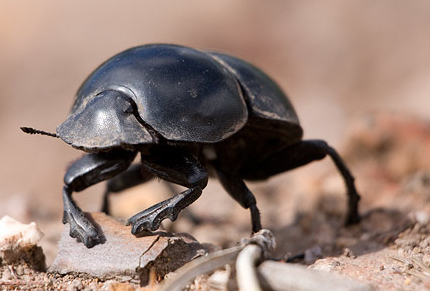
Dung beetles haven’t gotten much attention for the service they perform. Rolling and burying balls of dung isn’t everybody’s idea of a glamorous job.
But a University of Nebraska-Lincoln researcher says the insects are a key component in the health of Nebraska’s rangelands, which cover the majority of the state. And healthy rangeland is a foundation of beef production, the largest segment of Nebraska’s No. 1 industry, agriculture.
Sean Whipple, post-doctorate research associate based at the UNL Panhandle Research and Extension Center at Scottsbluff, is starting a project aimed at increasing our understanding of how dung beetles carry out their humble role. More specifically, he hopes to determine whether dung beetles prefer the taste of certain cow patties over others, based on the quality of forage that the cattle ingest.
Whipple said this knowledge could point the way to better range management.
The project is being conducted by Whipple with a pair of specialists at the Panhandle Research and Extension Center: Jeff Bradshaw, Extension Entomology Specialist, and Karla Jenkins, cow-calf/range management specialist. Jeanna Jenkins, an undergrad animal science major, also will be assisting this summer. She is partially supported through UNL’s UCARE (Undergraduate Creative Activities and Research Experience) Program.
It will involve an array of pitfall traps (5-gallon buckets) buried into some of the 1,600 acres of range at UNL’s High Plains Ag Lab near Sidney. Cow dung produced from several diets of varying forage quality will be compared in their ability to attract the beetles.
For such a humble subject, Whipple’s dung beetle research has gotten a lot of attention in the past several weeks, going viral on the World Wide Web and attracting notice from some top scientific web sites.
It started with a publication written by Whipple in the journal Environmental Entomology, which was posted on the Entomological Society of America’s web site. Science Daily, a web site with a readership of 2 million in North America alone, soon picked it up, and within a day or two it had shown up on more than 50 web sites, Whipple said. He’s been contacted for interviews by National Geographic News and a GEO, a German magazine.
The article that’s getting the attention actually describes research performed earlier by Whipple and W. Wyatt Hoback, into the beetles’ preference for dung from exotic species (in zoos or game farms, for example) compared to native species.
There are thousands of species of dung beetles, most of them scarab beetles. Not only do dung beetles directly benefit livestock production, but they also play a valuable role in nutrient cycling and rangeland health, Whipple explains.
“Most people associate dung beetles with the ones that roll the ball that you see on TV,” he said, and they also associate them with Africa more than North America. But he said Nebraska has more than 50 species of dung beetles. In the Panhandle, where this project will take place, there are upwards of 20 fairly common species.
Each cow in a herd will produce up to 20 dung pats per day. Dung beetles break them down faster and more efficiently than other agents, such as weathering or other types of small critters such as ants, termites or earthworms, Whipple said.
“They can potentially do in 48 hours what would take a couple years,” he said. “Through their actions, and burying, you get benefits such as soil aeration, control of flies and dung breeding pests, nutrient cycling and increased forage growth and acreage for cattle. They provide an ecosystem service benefitting not only plant communities but also livestock yield.”
The work done by dung beetles increases available acreage for cattle production by an estimated 5 to 10 percent. Their economic value to the United States is estimated at more than $380 million annually.
"The whole idea of my research is since they provide such a good service, how can we manage cattle and rangelands in a way to maximize dung beetle occurrence, thereby increasing the profit to ranchers.”
Several studies have examined feeding preference and niche partitioning of various dung beetle species. But little is known as to whether dung beetles can make use of cattle dung with low nutrient value.
Often, dung beetles have specific preference towards dung condition or odor, soil characteristics, habitat and seasonality. Dung beetles may not be able to adequately biodegrade low-quality dung.
Whipple received a Ph.D. in entomology last December from UNL, after receiving a master’s degree in biology from the University of Nebraska at Kearney. His master’s work focused on grasshoppers. For his doctoral work, he looked for a project in an understudied topic that applied to both entomology and rangeland ecology. “And dung beetles fit that. So I just sort of fell into it.”
He had met Bradshaw during the course of his studies. His post-doctoral research post came about through work he had done on potato psyllids, a pest of potatoes and several other crops. Bradshaw is allowing him to bring in some of his prior research on dung beetles. Whipple, Bradshaw and Jenkins have applied for seed funding from UNL’s Agricultural Research Division to perform the sampling at the High Plains Ag Lab.
Perhaps dung beetles will become more than an Internet phenomenon, and get recognition for their service to native rangelands in Nebraska and elsewhere.
“They provide a good service that not a lot of insects do and they do it very efficiently. It’s a topic that can benefit research not only in the entomology community, but has the potential to benefit agriculture as a whole. If we can get to a point where we can manage dung beetles and figure out what they need, what is optimal, we have a way to improve our range management practices.”